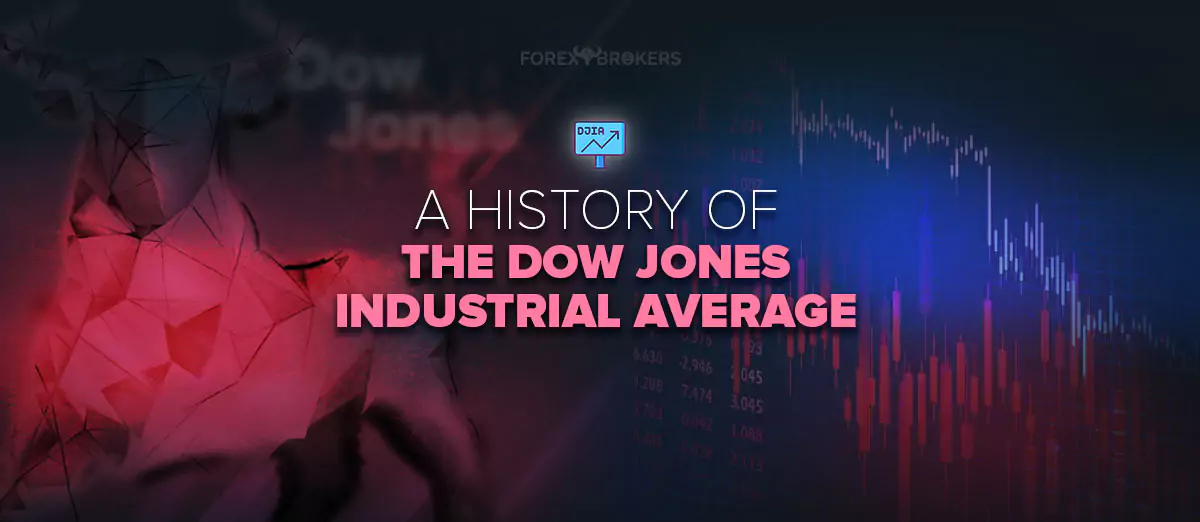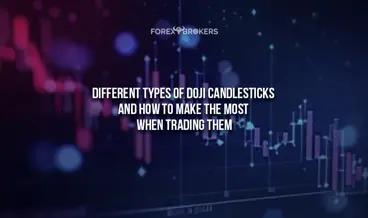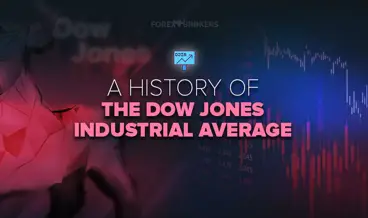The Dow Jones Industrial Average DJIA, or simply Dow Jones, or the Dow, is one of the world's most famous stock market indices. Certainly, it is one of the oldest, as in 2023, investors celebrated 127 years since the Dow’s creation. It is, therefore, not a coincidence that we chose to dedicate a full article part of this trading academy to the Dow and why it is so important to financial markets.
Stock market indices serve various purposes, but most importantly, they act as a benchmark for performance evaluation. They also act as a gauge for the market sentiment. For example, the S&P500 index is a gauge of the overall market. Thus, when traders refer to the S&P500, they often refer to the overall market.
This article presents the Dow Jones of the 21st century, looking at some changes in the past but mostly introducing the company’s part of the index. The Dow Jones serves as a benchmark for many investor managers to compare returns and assess performance.
We will also look at the index's returns over time and how they differ depending on the methodology used to calculate them. For example, the total return differs from the price return because it includes any income received over the period (i.e., dividend payments).
Finally, this article explains the difference between passive and active investing and why stock market indices are used to diversify a portfolio. The Dow Jones, as this article will point out, remains a symbol of the US equity markets, the largest and most important in the world. Because the US is the largest economy in the world and Americans are very much involved in the stock market, all foreign companies want to be listed in the US to gain access to American capital.
Dow Jones Industrial Average Origins
The DJIA index was launched in 1896 with a small number of companies – only twelve. Today, none of those twelve companies are still part of the DJIA, as the index has adapted to new economic realities. Also, nowadays, the Dow Jones is composed of thirty companies from various sectors.
It took the Dow ten years to break 100 points and another 66 years to trade for the first time above 1,000. In 1999, the Dow Jones index exceeded the 10,000 level, and since that moment, it has gained another 24,000 points despite 2 global recessions. As such, the Dow Jones currently trades above 34,000, a stunning performance in its 127 years of history.
Charles Dow is responsible for the creation of the Dow Jones index and he used his name and the name of his business associate, Edward Jones, to create the Dow Jones name. The initial companies part of the index were American Tobacco, American Sugar, American Cotton Oil, Chicago Gas, General Electric, Distilling and Cattle Feeding, Laclede Gas, National Lead, North American, Tennessee Coal, Iron, and Railroad, US Rubber and US Leather.
Out of the twelve names, the reader is probably familiar with General Electric, the only one that survived the test of time. However, General Electric is no longer part of the DJIA, having been replaced by Walgreens Boots Alliance in July 2018.
On the first day of trading, the Dow Jones Industrial Average had a value of 62.76 points. Since then, the components of the Dow have changed constantly. However, if we look at the number of changes (fifty-five) spread over the number of years since the Dow’s creation, their frequency of change no longer appears so high.
DJIA – Calculation Methodology
The Dow’s value is calculated by summing up the prices of the components and then dividing the outcome by a divisor. The divisor changes over time, based on how the components change, and it remains one of the variable factors in the Dow’s calculation. Also, one of the biggest drawdowns of the Dow Jones is that stocks with a higher price have a larger influence on the index’s performance/underperformance.
As mentioned earlier, the Dow’s components changed over time, with General Electric being the American corporation that survived in the index for the longest period. There are no specific conditions for a company to meet to be included in the Dow Jones index; the only relevant one is that it accounts for a big part of the economic activity in the United States.
This sharply contrasts some other indices, such as the S&P500. To be part of the S&P500, a company must show 4 profitable quarters in a row – just one example of the requirements.
On the Dow’s committee, there are 5 members – 2 from The Wall Street Journal and 3 from the S&P Global. Together, they decide the changes in the Dow Jones composition, the timing, and the adjustments to its divisor.
Two recent changes in the Dow Jones index were the replacement of General Electric with Walgreens Boots Alliance in 2018 and Apple replacing AT&T in 2015. Finally, in 2020, Salesforce.com replaced Exxon Mobil, Honeywell International replaced Raytheon Technologies and Amgen replaced Pfizer.
However, for a company to be dropped from the Dow or any other index is not necessarily a bad thing. Throughout history, we have seen numerous examples of companies that performed better once they were no longer part of a stock market index.
Dates to Remember in Dow Jones History
Before looking at 2021 Dow Jones components later in the article, it is useful to remember some of the relevant dates in the DJIA history. Also, there are some remarkable events worth remembering.
To start with, the Dow gained 7.7% on average per year. Considering the timespan, this is quite a performance, especially considering the possibility of compounding. Next, the best yearly performance for the index was in 1915. At that time, the Dow delivered an 82.7% return, which remained its best year ever.
How about the worst year? In the years that followed the Great Depression, the Dow suffered one of its largest drawdowns. The largest loss came in 1931 when the index lost 52.7% of its value.
The 1987 stock market crash caused the largest single-day drop in the index’s value. The Dow lost 22.6% that day. On the other hand, the best day was in 1933, when the Dow gained 15.3%.
Types of Stock Market Indices
Many types of stock market indices exist, with different rules regarding how to calculate their performance, how it is rebalanced, and what the conditions are for a company to be included in the index.
Stock market indices, the Dow included, do not have the same components all the time. In fact, from time to time, some companies are added to or excluded from the index, changing the structure and creating big problems for some investors. Because many investors follow a passive investing strategy, they mirror the components of an index. They, thus, are forced to liquidate the shares of a company that is being kicked out and add the shares of the new company that is added.
Another interesting aspect is that a company may be part of many indices. The best example is Microsoft, which is part of the Dow Jones, the S&P500, and the Nasdaq 100. This explains why the stock market indices in the United States are so correlated and why they rarely diverge.
Coming back to the equity indices, there are price indices, market capitalization indices, value-based, and fundamentally weighted indices. They all have their own particularities and it is important for a trader to know the type of an index before trading it, as events such as rebalancing may strongly impact a stock’s price.
2021 Dow Jones Components
The following sections of the article present some particularities of the companies part of the Dow Jones in 2021. We will focus on profitability, dividends, if any, stock market performance, and much more.
American Express
American Express (NYSE:AXP) was added to the Dow Jones in August 1982 and has been part of the index ever since. It employs over 63,000 people and is headquartered in New York. The company was founded in 1850 and is one of the leading corporations in the consumer finance and financial services sectors.
Key metrics to remember about American Express as of May 2021:
- Dividend-paying company: yes
- Gross profit margin TTM (Trailing Twelve Months): 73.11%
- 1-year stock market performance: 69.26%
- Return on common equity (ROE) TTM: 21.6% vs. sector median 11.12%

Amgen
Amgen is an American company active in the biotechnology and healthcare sectors. It is headquartered in Thousand Oaks, California, and employs over 24,000 people. Amgen became part of the Dow Jones index in August 2020 and is involved in delivering human therapeutics worldwide, focusing on neuroscience and cardiovascular diseases, among others.
Key metrics to remember about Amgen as of May 2021:
- Dividend-paying company: yes
- Gross profit margin TTM (Trailing Twelve Months): 75.62%
- 1-year stock market performance: 5.11%
- Return on common equity (ROE) TTM: 75.30% vs. sector median -33.93%
Apple
Everyone knows Apple as it is one of the most famous brands worldwide. The company from Cupertino, California, joined the Dow Jones index in March 2015, and it is an active player in the technology hardware, storage, and peripherals industry. As one of the leading companies in the information technology sector, Apple is a dividend-paying stock, which makes it even more attractive to investors. Apple’s products are well known, from smartphones to tablets and more.
Key metrics to remember about Apple as of May 2021:
- Dividend-paying company: yes
- Gross profit margin TTM (Trailing Twelve Months): 39.88%
- 1-year stock market performance: 54.71%
- Return on common equity (ROE) TTM: 103.40% vs. sector median 6.86%

Boeing
From Chicago, Illinois, Boeing is a leader in the aviation industry, as well as other industries. Investors know Boeing for its commercial airplane business and its rivalry with Airbus, a European competitor. Still, the company also runs a successful business in missile defense and human space flight. Boeing employs over 141,000 people, was added to the Dow Jones in March 1987 and is one of the oldest corporations in America, in existence since 1918.
Key metrics to remember about Boeing as of May 2021:
- Dividend-paying company: no
- Gross profit margin TTM (Trailing Twelve Months): -1.39%
- 1-year stock market performance: 66.73%
- Return on common equity (ROE) TTM: N/A - sector median 11.12%

Caterpillar
From Deerfield, Illinois, the United States, Caterpillar, or simply CAT, has a strong presence in the industrial sector and is a leading company in the heavy trucks and construction machinery industry. Founded in 1925, it employs over 97,000 people worldwide and was formerly known as Caterpillar Tractor Co. Caterpillar joined the Dow Jones index in May 1991.
Key metrics to remember about Caterpillar as of May 2021:
- Dividend-paying company: yes
- Gross profit margin TTM (Trailing Twelve Months): 25.15%
- 1-year stock market performance: 97.42%
- Return on common equity (ROE) TTM: 22.33% vs. sector median 9.81%
Chevron
Chevron runs an integrated oil and gas business in the energy sector, an industry recently under severe strain. The drop in the oil price during the 2020 COVID-19 pandemic has created some tectonic shifts in the industry, with many major players being affected. However, Chevron managed to weather the environment and quickly became one of the leaders in its sector. Chevron was added to the Dow Jones index in February 2008.
Key metrics to remember about Chevron as of May 2021:
- Dividend-paying company: yes
- Gross profit margin TTM (Trailing Twelve Months): 45.17%
- 1-year stock market performance: 14.14%
- Return on common equity (ROE) TTM: -5.63% vs. sector median -3.25%
Cisco
Cisco is a leader in the communications equipment industry and employs over 77,000 people. This is a dividend-paying company in a promising industry and it joined the Dow Jones index in June 2009. It is one of the companies that are representative of the tech sector, even though it did not perform like its peers did during the 2020 COVID-19 pandemic. Nevertheless, besides paying a dividend, it has an impressive gross profit margin.
Key metrics to remember about Cisco as of May 2021:
- Dividend-paying company: yes
- Gross profit margin TTM (Trailing Twelve Months): 63.94%
- 1-year stock market performance: 12.95%
- Return on common equity (ROE) TTM: 26.92% vs. sector median 6.86%
Coca-Cola
Another globally-known brand, Coca-Cola, sells various non-alcoholic beverages around the world and is one of the leaders in the consumer staples sector. From Atlanta, Georgia, The Coca-Cola Company employs over 80,000 people and was founded before 1900. Coca-Cola was added to the Dow Jones index in March 1987 and is one of the preferred companies to invest in by investors looking for dividends.
Key metrics to remember about Coca-Cola as of May 2021:
- Dividend-paying company: yes
- Gross profit margin TTM (Trailing Twelve Months): 54.92%
- 1-year stock market performance: 18.34%
- Return on common equity (ROE) TTM: 37.48% vs. sector median 11.67%

Dow
Dow joined the Dow Jones index in April 2019 and the similarity of the 2 names is just a coincidence. Dow Inc. replaced DowDuPont Inc. and is an active player in the materials sector commodity chemicals industry. Headquartered in Midland, Michigan, Dow Inc. employs over 37,000 people worldwide.
Key metrics to remember about Dow as of May 2021:
- Dividend-paying company: yes
- Gross profit margin TTM (Trailing Twelve Months): 13.44%
- 1-year stock market performance: 68.83%
- Return on common equity (ROE) TTM: 14.60% vs. sector median 10.18%
Goldman Sachs
Goldman Sachs joined the Dow Jones index in September 2013 and is a global leading financial services firm. It was founded in 1869 and employs over 40,000 people in the investment banking and brokerage industry. Goldman Sachs has been a dividend-paying company for more than 2 decades.
Key metrics to remember about Goldman Sachs as of May 2021:
- Dividend-paying company: yes
- Gross profit margin TTM (Trailing Twelve Months): 88.78%
- 1-year stock market performance: 87.83%
- Return on common equity (ROE) TTM: 17.07% vs. sector median 11.12%
Home Depot
Another company from Georgia, this time from Atlanta, Home Depot, has been a dividend-paying company for over three decades. It employs over 500,000 people and operates close to 3,000 stores in the United States, Canada, and Mexico. Home Depot was added to the Dow Jones index in November 1999.
Key metrics to remember about Home Depot as of May 2021:
- Dividend-paying company: yes
- Gross profit margin TTM (Trailing Twelve Months): 33.94%
- 1-year stock market performance: 23.95%
- Return on common equity (ROE) TTM: N/A vs. sector median 10.87%
Honeywell
Founded in 1985 in Charlotte, North Carolina, Honeywell International is an industrial conglomerate from the United States that employs over 100,000 people. Honeywell was added to the Dow Jones index in August 2020, and it runs a diversified technology and manufacturing business worldwide, such as data and service applications, flight safety, aircraft lighting, etc.
Key metrics to remember about Honeywell as of May 2021:
- Dividend-paying company: yes
- Gross profit margin TTM (Trailing Twelve Months): 31.52%
- 1-year stock market performance: 55.54%
- Return on common equity (ROE) TTM: 25.96% vs. sector median 9.81%
IBM
IBM has been a Dow Jones constituent since 1976 and is a world leader in IT consulting and other services. The company has a history of more than thirty consecutive years of paying dividends, and it is one of the companies that were extremely popular during the tech boom in the late 90s. IBM is headquartered in Armonk, New York.
Key metrics to remember about IBM as of May 2021:
- Dividend-paying company: yes
- Gross profit margin TTM (Trailing Twelve Months): 48.60%
- 1-year stock market performance: 15.65%
- Return on common equity (ROE) TTM: 25.52% vs. sector median 6.86%
Intel
Intel Corporation was established in 1968 and designs and sells technologies for the cloud, as well as connectivity and memory and storage products, among other products and services. Headquartered in Santa Clara, California, Intel joined the Dow Jones index in November 1999. Intel is a dividend-paying company and employs over 110,000 people worldwide.
Key metrics to remember about Intel as of May 2021:
- Dividend-paying company: yes
- Gross profit margin TTM (Trailing Twelve Months): 54.62%
- 1-year stock market performance: -7.47%
- Return on common equity (ROE) TTM: 23.82% vs. sector median 6.86%

Johnson & Johnson
Johnson & Johnson is an American corporation from New Brunswick, New Jersey, with operations in the pharmaceuticals industry, and it is a leader in the healthcare sector. It was established in 1886 and employs over 134,000 people. The company has split its business into 3 core parts – medical devices, pharmaceutical, and consumer health, and it joined the Dow Jones index in March 1997.
Key metrics to remember about Johnson & Johnson as of May 2021:
- Dividend-paying company: yes
- Gross profit margin TTM (Trailing Twelve Months): 66.38%
- 1-year stock market performance: 12.11%
- Return on common equity (ROE) TTM: 23.78% vs. sector median -33.93%
JPMorgan Chase
JPMorgan Chase is one of the leading conglomerates in the financial sector, with investing activities worldwide. The House of Morgan has well-established roots on all continents, and its financial activities have been tracked for more than 2 centuries. The company was founded in 1799 and is one of the most prolific in the United States. It was added to the index in May 1991.
Key metrics to remember about JPMorgan Chase as of May 2021:
- Dividend-paying company: yes
- Gross profit margin TTM (Trailing Twelve Months): N/A
- 1-year stock market performance: 67.89%
- Return on common equity (ROE) TTM: 16.17% vs. sector median 11.12%
McDonald's
Another company that needs no introduction is McDonald’s. Its brand name has worldwide notoriety, and the company is a restaurant industry leader. It was established in 1940 and joined the Dow Jones index in October 1985.
Key metrics to remember about McDonalds as of May 2021:
- Dividend-paying company: yes
- Gross profit margin TTM (Trailing Twelve Months): 51.37%
- 1-year stock market performance: 24.62%
- Return on common equity (ROE) TTM: N/A vs. sector median 10.87%

Merck
From Kenilworth, New Jersey, Merck is a healthcare company active in the pharmaceuticals sector. It was established in 1891 and joined the Dow Jones index in June 1979. It has a dividend payout ratio of 40.21% and a dividend yield of 3.59% as of May 2021.
Key metrics to remember about Merck as of May 2021:
- Dividend-paying company: yes
- Gross profit margin TTM (Trailing Twelve Months): 71.61%
- 1-year stock market performance: -6.15%
- Return on common equity (ROE) TTM: 26.44% vs. sector median -33.93%
Microsoft
Microsoft was established in 1975 and it develops and supports software, services and products in the IT sector. It is a leader in the systems software industry and employs over 160,000 people worldwide. It joined the Dow Jones index in November 1999.
Key metrics to remember about Microsoft as of May 2021:
- Dividend-paying company: yes
- Gross profit margin TTM (Trailing Twelve Months): 68.38%
- 1-year stock market performance: 33.74%
- Return on common equity (ROE) TTM: 44.99% vs. sector median 6.86%

Nike
Nike was established in 1964 and has been part of the Dow Jones since September 2013. Headquartered in Beaverton, Oregon, Nike competes in the footwear industry and is a leader in the consumer discretionary sector.
Key metrics to remember about Nike as of May 2021:
- Dividend-paying company: yes
- Gross profit margin TTM (Trailing Twelve Months): 43.36%
- 1-year stock market performance: 33.18%
- Return on common equity (ROE) TTM: 32.68% vs. sector median 10.87%

Procter & Gamble
The Procter & Gamble Company is known worldwide for its products sold under brand names like Head & Shoulders, Braun, Gillette, and Old Spice. It has been part of the Dow Jones index since May 1982.
Key metrics to remember about Procter & Gamble as of May 2021:
- Dividend-paying company: yes
- Gross profit margin TTM (Trailing Twelve Months): 52.39%
- 1-year stock market performance: 13.04%
- Return on common equity (ROE) TTM: 30.84% vs. sector median 11.67%
Salesforce
Salesforce joined Dow Jones in August 2020 and it develops cloud computing solutions, among other services and products. The company was established in 1999 in San Francisco, California.
Key metrics to remember about Salesforce as of May 2021:
- Dividend-paying company: no
- Gross profit margin TTM (Trailing Twelve Months): 74.32%
- 1-year stock market performance: 34.66%
- Return on common equity (ROE) TTM: 11.52% vs. sector median 6.86%
Travelers
Travelers has been part of the Dow Jones index since June 2009 and operate in the property and casualty insurance industry. It was founded in 1853 and employs over 30,000 people. Travelers are based in New York and operate through three distinct business segments: personal insurance, business insurance, and bond & specialty insurance.
Key metrics to remember about Travelers as of May 2021:
- Dividend-paying company: yes
- Gross profit margin TTM (Trailing Twelve Months): 25.57%
- 1-year stock market performance: 44.32%
- Return on common equity (ROE) TTM: 10.51% vs. sector median 11.12%
UnitedHealth
From Minnetonka, Minnesota, UnitedHealth Group Incorporated operates in the managed healthcare industry, employing over 300,000 people. The business was established in 1977 and joined the Dow Jones index in September 2012. A dividend-paying company, UnitedHealth is a leader in the American healthcare industry.
Key metrics to remember about UnitedHealth as of May 2021:
- Dividend-paying company: yes
- Gross profit margin TTM (Trailing Twelve Months): 26.24%
- 1-year stock market performance: 33.60%
- Return on common equity (ROE) TTM: 27.37% vs. sector median -33.93%
Verizon
Verizon operates in integrated telecommunication services and offers its customers communications, technology, and entertainment products and services. It joined the Dow Jones index in April 2004 and is headquartered in New York. The company employs over 130,000 people and was founded in 1983.
Key metrics to remember about Verizon as of May 2021:
- Dividend-paying company: yes
- Gross profit margin TTM (Trailing Twelve Months): 59.53%
- 1-year stock market performance: 0.26%
- Return on common equity (ROE) TTM: 28.74% vs. sector median 4.48%
Visa
A payment technology company, Visa is based in San Francisco, California. Founded in 1958, the company employs over 20,000 people. Visa has been part of the Dow Jones index since September 2013 and it is a leader in the data processing and outsourced services industry. Visa is a dividend-paying company with a dividend payout ratio of 22.78%.
Key metrics to remember about Visa as of May 2021:
- Dividend-paying company: yes
- Gross profit margin TTM (Trailing Twelve Months): 96.65%
- 1-year stock market performance: 15.87%
- Return on common equity (ROE) TTM: 32.57% vs. sector median 6.86%
Walgreens Boots Alliance
Walgreens Boots Alliance, or simply Walgreens, is a drug retail company active in the consumer staples sector. From Deerfield, Illinois, Walgreens was founded in 1901 and employs over 270,000 people worldwide. It is involved in the retail and wholesale pharmaceutical industries. Walgreens has been part of the Dow Jones index since June 2018.
Key metrics to remember about Walgreens Boots Alliance as of May 2021:
- Dividend-paying company: yes
- Gross profit margin TTM (Trailing Twelve Months): 19.39%
- 1-year stock market performance: 25.59%
- Return on common equity (ROE) TTM: -2.90% vs. sector median 11.67%
Walmart
Walmart is one of the most successful businesses in the United States. The company operates retail and wholesale units worldwide and also runs e-commerce websites in over twenty-five countries. Walmart joined the Dow Jones index in March 1997 and is headquartered in Bentonville, Arizona. It employs over 2 million people worldwide and is one of the world’s leading companies active in the hypermarkets and supercenters industry. Founded in 1945, Walmart is a dividend-paying company with a forty-five-year dividend growth history and a payout ratio of 37.21%.
Key metrics to remember about Walmart as of May 2021:
- Dividend-paying company: yes
- Gross profit margin TTM (Trailing Twelve Months): 25.10%
- 1-year stock market performance: 14.68%
- Return on common equity (ROE) TTM: 16.71% vs. sector median 11.67%

Walt Disney
Walt Disney’s brand is famous around the world, known for its Mickey character, plus much more. The company was severely affected by the COVID-19 pandemic, especially in its entertainment parks sector.
Now that economies worldwide are recovering from the recession and reopening, Walt Disney stands to benefit. Walt Disney does not currently pay a dividend despite having a long dividend-paying history. Most likely, it will resume paying it once the pandemic is over and profitability is back on track. The company is a leader in the movies and entertainment industry, as well as the communication services sector, and it is based in Burbank, California.
Key metrics to remember about Walt Disney as of May 2021:
- Dividend-paying company: no
- Gross profit margin TTM (Trailing Twelve Months): 30.65%
- 1-year stock market performance: 44.25%
- Return on common equity (ROE) TTM: -5.10% vs. sector median 4.48%

Dow Jones during COVID-19 Pandemic
The Dow Jones index, like other stock market indices around the world, collapsed during the start of the COVID-19 pandemic. When the dangers ahead became clear to the investing world, the stock market indices fell, triggering the circuit breakers.
For those not familiar with circuit breakers, they are existing mechanisms designed to stop an unorderly decline in prices. In other words, the first circuit breaker is reached if the market declines over a certain level, percentage-wise, during a trading day. Effectively, trading stops for a while and then resumes. The circuit breakers are intended to give everyone a fair chance to get out, should they want to do so in a declining market.
As it turned out, the pandemic triggered the fastest move from a bull to a bear market in history. When the value of a stock market index such as the Dow Jones drops by more than 20% from the top, it is said that a bear market has started.
However, the bounce back to bullish territory was even quicker. Investors realized that the fiscal and monetary stimulus governments and central banks provided would be enough to support the economies until science arrived to help – and they were right. The prospect of efficient vaccines has led many stock market indices, the Dow Jones included, to rise to new all-time highs.
Conclusion
The US stock market is the largest equity market in the world. Every major company with global aspirations that wants to access American capital is looking to be listed on the North American stock exchanges.
For this reason, the US stock market indices, such as the Dow Jones index presented in this article, are closely monitored by market participants worldwide. Their daily moves and performance represent a benchmark for the way the American economy performs. Also, stock market indices are leading indicators of economic growth, closely monitored by traders that adjust positions based on the changes in the business cycle.
Even though the S&P500 is viewed as the benchmark for the overall market, the Dow Jones is also used in assessing performance in the investment industry. For dividend-seeking investors, the Dow Jones constituents are a first-tier source of information.






















